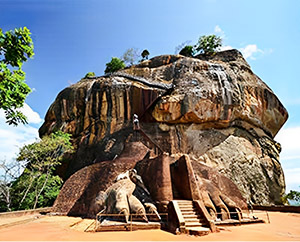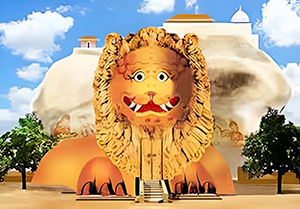Sigiriya Lion Staircase & Gatehouse

The Lion Staircase Sigiriya, Sri Lanka was built by King Kashyapa over 1600 years ago to guard the final entrance to his Sky Palace on top of Sigiriya Rock.
It is situated on a small escarpment about half-way up the northern side of Sigiriya rock. The paws and staircase are all that remain of a once colossal gatehouse built in the form of a crouching sphinx-like lion. It guarded the final entrance to the inmost sanctum of the entire complex: the Sky Palace of the god-king on the summit. While it is commonly referred to as the Lion Staircase a more correct definition would be Lion Gatehouse.
The Lion Staircase was thirty-five meters high, twenty-one meters wide and protruded eleven meters from the rock face. The remnants of the giant paws with fingernails as tall as a man give us a clear indication of its original size. Brightly colored, eyes ablaze and its mouth agape it appeared ready to swallow anyone who dared approach it.
It is the only feature that is specifically mentioned in the ancient chronicle of Sri Lanka, the Culavamsa; which refers to it as Sīhāgiri – Lion Rock.

A semi-circular granite moonstone lies at the base of a narrow flight of limestone steps leading up to an entryway which was once protected by cleverly disguised doors which opened out from the mane on the lion's chest. Just inside this entryway was another flight of stairs which proceeded in zigzag fashion inside the lion's head and reappeared behind the head. The stairs then lead up a passageway to the Sky Palace on the summit.
Graffiti found on the Mirror Wall confirms the existence of this colossus and also that it survived for many centuries after Sigiriya was abandoned as a royal citadel. A 9th century graffiti (that is nearly 300 years after it was built) reads:
Having ascended Sigiriya to see what is there
I fulfilled my mind's desire
and saw His Lordship the Lion....
